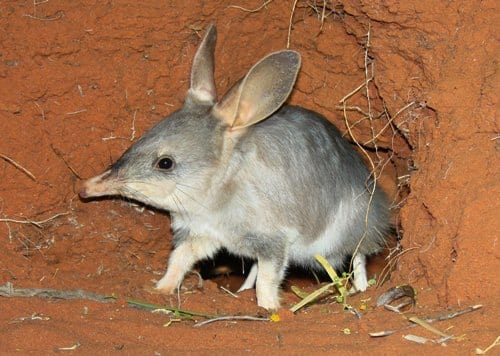Happy 81st Thylacine Day: Thylacines were lucky to last as long as they did
By Jack Ashby, on 7 September 2017
81 years ago today – the 7th September 1936 – the last known thylacine died, committing its species, indeed its entire family, to extinction.

The last known living thylacine, 1933. (Image in the public domain, photographer unknown)
It was locked out of the indoor section of its enclosure at a zoo in Hobart, and in the overnight chill of the Tasmanian winter it died of exposure. All that now remains of the then largest marsupial carnivore is in museums.
In a sense it was lucky.
Lucky, at least, to have survived that long.
Over the last few weeks I’ve also been lucky: lucky to have been on fieldwork working with threatened species in Australia, the global capital of mammal extinction. There, the plague of introduced cats, foxes and other significant threats has decimated the native fauna. As discussed in a previous post about bilbies, I visited Arid Recovery, who have reintroduced species to mainland Australia which had been driven to the brink of total extinction. Conversations with ecologists there – Katherine Tuft and Hugh McGregor – made me think about the role of luck in extinction.

Competition with (and perhaps predation by) dingoes drove thylacines to extinction on the mainland. (C) Jack Ashby
Why was the thylacine lucky? This species once ranged across mainland Australia. It became extinct there around 2,000 years ago. There are a number of factors which contributed to their extinction, but among them was competition with dingoes, which were introduced to Australia by people 3-4,000 years ago. Dingoes never made it to Tasmania, and it seems reasonable to assert that luck played a role in that: canids with similar biologies certainly thrive in similar habitats elsewhere.
In the absence of dingoes, and perhaps with a lower population density of Aboriginal Australians, the thylacines were able to survive on the island of Tasmania for millennia after their extinction on the mainland. Their luck only ran out in the last two centuries, when the political pressure of a powerful but misguided farming lobby deliberately drove the thylacine to extinction.
Since the European invasion of Australia in 1788, on the whole Australia’s wildlife has been incredibly unlucky. The agents of extinction that Europeans brought with them – predators to eat them, herbivores to starve them, changed fire regimes, drastically altered habitats, direct hunting, invasive plants and even climate change – have brought the native fauna to its knees. Aside for the 29 (at a minimum) extinctions, the vast majority of Australian mammal species have suffered significant reductions in their distributions.
It is as fascinating as it is critical to establish what it is about the species that survived that enables them to survive in the new, post-1788 Australia (albeit in drastically reduced numbers). What it is about the bilby, for example, that means it is not yet extinct, while similarly sized mammals with similar historic ranges have all gone? What does the bilby have that desert bandicoots didn’t? What has kept bridled nail-tailed wallabies alive (just) which crescent nail-tailed wallabies lacked?
Luck seems to have played a huge role in the survival of species on islands. Much like the thylacines never had to contend with dingoes on Tasmania, many species have clung-on on island havens where cats, foxes, rabbits or other invasive species never reached.
Aside from bilbies, Arid Recovery has reintroduced greater stick-nest rats, western barred bandicoots and burrowing bettongs. These three species had all disappeared from mainland Australia, but, at least partly by chance, clung on a couple of islands. Had the threats which wiped them out from the mainland been at play to the same extent on their island refuges, they would no longer exist.

Burrowing bettongs became extinct on mainland Australia, but survived on a couple of islands. (C) Jack Ashby
All around Australia, islands have given sanctuary to species that have disappeared from every other part of their former range since Europeans arrived. It wasn’t just the thylacine that benefitted from the Bass Straight which isolates Tasmania. Following their recent extinctions elsewhere in Australia, in the absence of foxes, Tasmania was the last refuge of the Tasmanian devil, the eastern quoll, the Tasmanian bettong and the Tasmanian pademelon (until recent reintroductions of some species to fenced predator-free exclosures on the mainland). Similar stories are told by many other offshore landmasses.
Many species survive man-made extinction pressures as a result of natural selection: they evolved advantageous characteristics which kept them alive. However, that isn’t the only factor at play. Sometimes storms, floods, disease or droughts may make the habitat unliveable across a species’ entire range, and there is undoubtedly an element of luck – bad luck – to those events. They were unlucky enough to be in the wrong place. Similarly, species are lucky to cling on and avoid extinction in refuges – often islands – which don’t experience these calamities.
In the case of Australia, chance has played a role in keeping some islands free of the invasive species that came with European settlement. We should count ourselves lucky that this enabled some of the species that were found on those islands to endure.
Happy Thylacine Day. Lest we forget.
Jack Ashby is Manager of the Grant Museum of Zoology
 Close
Close


